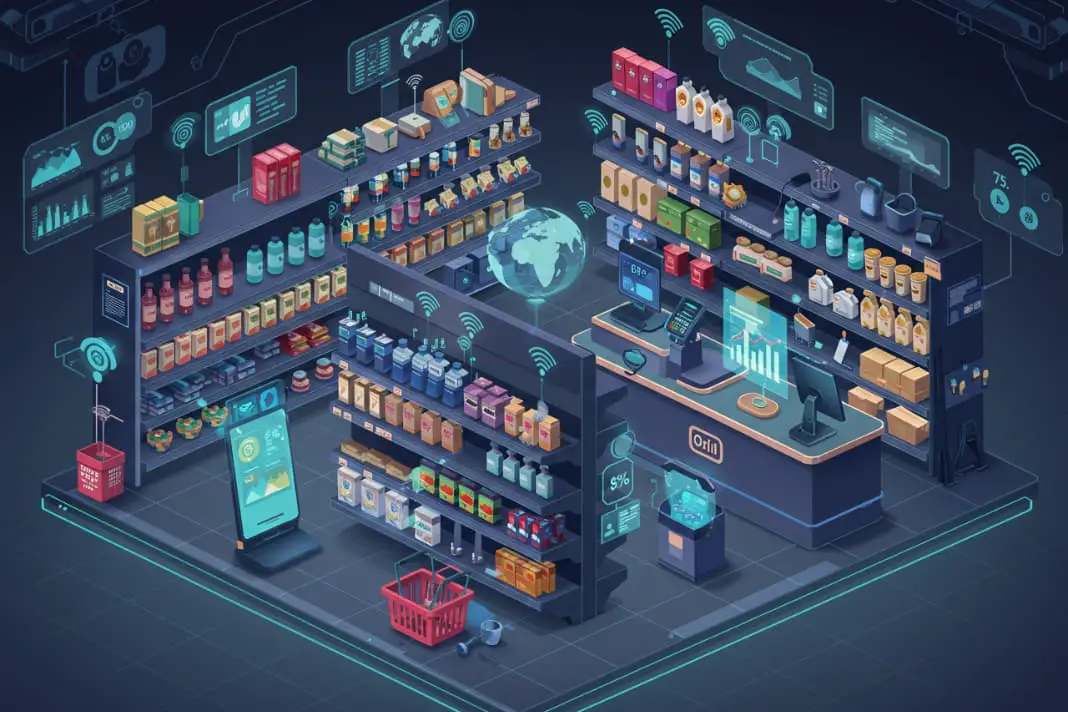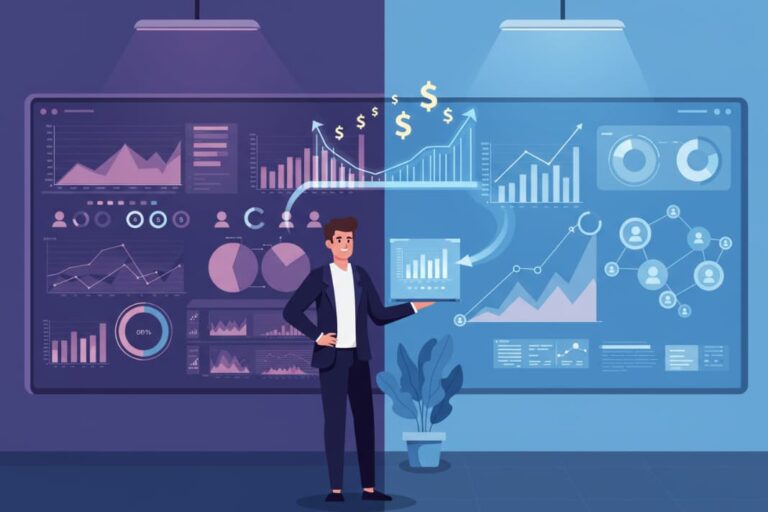The retail landscape has changed dramatically over the past decade. Brick-and-mortar stores now compete with online giants, customer expectations have soared, and profit margins have tightened. In this challenging environment, IoT in retail analytics has emerged as a game-changing approach for stores seeking to regain their competitive edge.
Smart sensors, connected devices, and data analysis tools now allow retailers to understand their operations and customer behavior with unprecedented clarity. This transformation is moving retail from gut-based decisions to data-driven strategies that boost sales, cut costs, and build customer loyalty.
This article explores how IoT in retail analytics is reshaping trade strategies through sensor data. We’ll examine the technologies driving this change, explore real-world applications, and consider future trends that will continue to transform the shopping experience.
Key Takeaways
- Retail sensor networks boost inventory accuracy by up to 30% and reduce stockouts
- Major brands like Walmart and Target have achieved measurable sales growth using IoT analytics
- Smart shelves, RFID tags, and computer vision systems form the backbone of retail IoT
- Real-time data enables dynamic pricing and personalized customer experiences
- Edge computing and 5G are driving the next wave of retail IoT innovation
What Is IoT in Retail?
IoT in retail analytics refers to the network of interconnected sensors, devices, and systems that collect and analyze data throughout the retail environment.
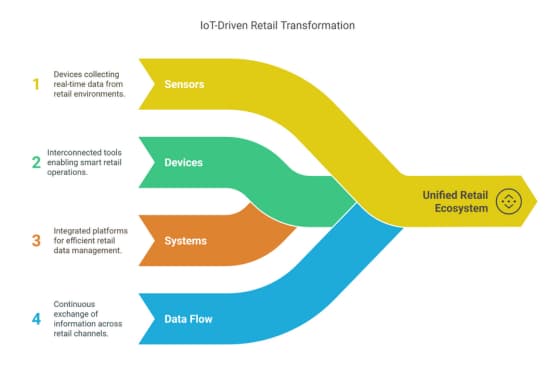
Unlike traditional retail systems that operate in isolation, IoT creates a unified ecosystem where data flows seamlessly between physical spaces and digital platforms.
The Connected Store Ecosystem
This connected approach allows retailers to track products from warehouse to shelf, monitor customer interactions in real-time, and make data-driven decisions that would be impossible with conventional methods. The result is a retail environment that can adapt quickly to changing conditions and customer needs.
A typical IoT-enabled store contains dozens or even hundreds of sensors and connected devices working together to create a complete picture of retail operations.
These might include inventory trackers, foot traffic sensors, environmental monitors, and customer engagement tools, all feeding data into a central analytics platform.
Key Technologies Powering IoT in Retail
RFID & Smart Shelves
Radio Frequency Identification (RFID) tags and smart shelves form the backbone of many retail IoT systems. RFID tags attach to individual products or shipping containers, broadcasting their location and status to nearby readers. This creates real-time inventory visibility that far surpasses traditional methods.
Smart shelves take this concept further by incorporating weight sensors, display capabilities, and even cameras. These enhanced fixtures can detect when products are removed, automatically trigger restocking requests, and update digital price displays based on current promotions or inventory levels.
Walmart has been a pioneer in RFID implementation, using the technology to track inventory across its massive supply chain.
This system has helped the retail giant reduce stockouts by 30% and significantly improve supply chain efficiency, driving increased sales through better stock management.
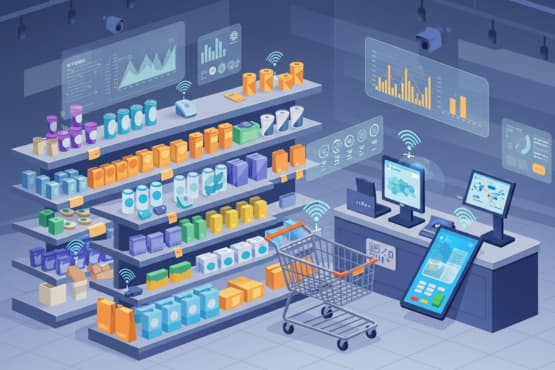
Beacons & Proximity Marketing
Bluetooth Low Energy (BLE) beacons are small transmitters that communicate with nearby smartphones through retail apps. When customers enter specific store areas, beacons can trigger personalized offers, product information, or wayfinding assistance directly to their devices.
These systems create opportunities for highly targeted marketing based on precise in-store location data. For example, a customer lingering in the coffee aisle might receive a mobile coupon for a complementary product like cream or filters, driving additional purchases.
Target has successfully deployed beacon technology to enhance its mobile app experience. When customers enter a Target store with the app installed, they receive store-specific deals, product recommendations based on their shopping history, and navigation assistance to find items on their list.
Environmental Sensors & Computer Vision
Modern retail spaces increasingly rely on environmental sensors and computer vision systems to monitor store conditions and customer behavior. Temperature sensors ensure products remain at optimal conditions, while humidity monitors protect sensitive merchandise.
Computer vision systems use cameras and AI algorithms to analyze customer movement patterns, identify high-traffic areas, and even detect potential theft.
These systems can create heat maps showing where customers spend the most time, helping retailers optimize store layouts and product placement.
Premier Anti-Aging Corporation in Japan has implemented camera AI and IoT sensors to track customer behavior in their stores. The system monitors dwell time and product engagement, providing actionable insights for product placement and staff training that have directly improved sales performance.
NFC Payments & Mobile Integration
Near Field Communication (NFC) technology enables contactless payments and creates seamless connections between physical products and digital experiences. NFC tags can trigger product information displays, loyalty program interactions, or instant checkout options when scanned with a smartphone.
This technology bridges the gap between online and in-store shopping, allowing customers to access digital features while browsing physical products. For example, tapping an NFC tag on a clothing rack might bring up online reviews, available sizes, or suggested accessories on a customer’s smartphone.
Amazon Go stores represent the ultimate expression of integrated payment technology. Using a combination of computer vision, sensor fusion, and deep learning, these stores allow customers to simply pick up products and walk out, with payment automatically processed through their Amazon accounts without any checkout process.
Sensor Data Collection & Management
Types of Retail Sensors
The modern retail environment employs a diverse array of sensors, each collecting specific types of data that contribute to a comprehensive understanding of store operations and customer behavior.

Occupancy & Motion Sensors
These sensors track customer movement throughout the store, creating valuable data about traffic patterns, dwell times, and conversion rates. By understanding how customers navigate the space, retailers can optimize store layouts, staffing levels, and promotional displays.
Starbucks uses traffic analysis to determine optimal store locations and layouts. By gathering data on customer movement patterns and high-traffic zones, the coffee giant has achieved a 15% revenue increase through better site selection and in-store layout optimization.
Temperature & Environmental Monitors
For retailers selling perishable goods, temperature monitoring is essential for maintaining product quality and meeting regulatory requirements. These sensors track environmental conditions throughout the supply chain and in-store, alerting staff to potential issues before they affect product quality.
Kroger has implemented temperature monitoring throughout its cold chain, ensuring that perishable products remain at optimal conditions from warehouse to store shelf. This system has reduced waste and improved food safety compliance across the company’s extensive network of supermarkets.
Eye-Tracking & Weight Sensors
Advanced retail analytics can now track which products catch customer attention and how they interact with merchandise. Eye-tracking sensors monitor which displays attract the most visual interest, while weight sensors on shelves detect when products are picked up, examined, and either purchased or returned to the shelf.
This granular data helps retailers understand the customer decision journey in unprecedented detail.
For example, if many customers pick up a product but return it to the shelf without purchasing, this might indicate pricing issues or packaging confusion that can be addressed to improve conversion rates.
Data Processing & Security
The massive volume of data generated by retail IoT systems presents significant challenges for storage, processing, and security. Retailers must implement robust data management systems that balance real-time analytics capabilities with strong privacy protections.
Edge computing has emerged as a valuable approach for retail IoT, processing data locally on devices or in-store servers before sending aggregated insights to the cloud. This reduces bandwidth requirements, improves response times, and enhances privacy by keeping raw data closer to its source.
Data security and customer privacy remain primary concerns for IoT implementation. Retailers must comply with regulations like GDPR and CCPA while maintaining transparent data policies that build customer trust. This includes implementing strong encryption, access controls, and data minimization practices throughout the IoT ecosystem.
Real-World Applications of IoT Analytics
Inventory Optimization
Perhaps the most immediately valuable application of IoT in retail is inventory management. Traditional inventory systems rely on periodic manual counts and point-of-sale data, creating significant gaps in visibility that lead to stockouts, overstock situations, and lost sales.
IoT-based inventory systems provide continuous, automated monitoring that transforms this fundamental retail function. RFID tags track products from the distribution center to the sales floor, smart shelves detect when items are running low, and predictive analytics anticipate future demand based on historical patterns and current trends.
Walmart’s extensive RFID implementation demonstrates the power of this approach. By tracking inventory in real-time across its supply chain, the company has reduced stockouts by 30% while simultaneously reducing excess inventory.
This balanced approach has directly improved sales through better product availability while reducing carrying costs.
Customer Behavior Analytics
Understanding how customers interact with the store environment has traditionally relied on limited tools like manual observation or basic traffic counters. IoT sensors dramatically expand this capability, creating detailed data about customer movement, engagement, and decision-making.
Heat mapping technology uses ceiling-mounted sensors to track movement patterns throughout the store, identifying high-traffic areas, bottlenecks, and underutilized spaces.
This information helps retailers optimize store layouts, place high-margin products in prime locations, and ensure efficient customer flow.
Product interaction tracking takes this analysis to the individual item level. By monitoring which products customers pick up, examine, and either purchase or return to the shelf, retailers gain insight into the decision-making process that influences buying behavior.
Premier Anti-Aging Corporation in Japan has used this approach to transform its product displays and staff training.
By analyzing which products attract the most attention but have lower conversion rates, the company identified opportunities for better customer education and targeted sales associate training.
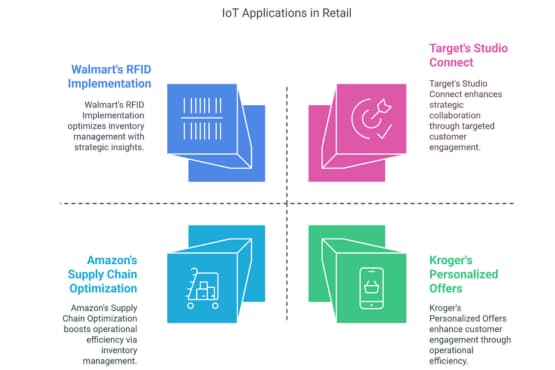
Trade Promotions & Retail Partnerships
Trade marketing—the strategic collaboration between manufacturers and retailers—benefits significantly from the data richness provided by IoT systems. Rather than relying on aggregated sales data and limited customer insights, IoT creates detailed views of how promotional activities influence behavior.
Location-based marketing through beacon technology allows retailers and brand partners to deliver targeted promotions based on precise in-store location.
A customer lingering in the snack aisle might receive a special offer for a new chip flavor, driving trial purchases and brand engagement.
Data sharing between retailers and brands becomes more valuable with IoT-enhanced information. Rather than sharing basic sales figures, retailers can now provide brand partners with detailed data about product interaction, display effectiveness, and customer engagement, creating opportunities for more strategic collaboration.
Target has pioneered this approach with its Studio Connect platform, which allows direct collaboration between the retailer and its brand partners.
Using data from in-store IoT systems, Target and its suppliers can jointly develop more effective promotions, optimize product placement, and create better shopping experiences.
Supply Chain Optimization
IoT extends visibility throughout the retail supply chain, creating transparency that was previously impossible. RFID tags, GPS trackers, and environmental sensors monitor products from manufacturer to store shelf, providing real-time information about location, condition, and estimated arrival times.
This enhanced visibility reduces delays, prevents losses, and ensures product quality throughout the supply chain.
For temperature-sensitive items like food or pharmaceuticals, continuous monitoring ensures that products remain within acceptable conditions during transportation and storage.
Amazon has built perhaps the most sophisticated IoT-enabled supply chain in retail. The company uses connected devices at every stage of its fulfillment process, from warehouse robots to delivery tracking systems.
This comprehensive approach has helped Amazon achieve industry-leading efficiency and reliability in its logistics operations.
Retail Pricing & Personalized Offers
Traditional pricing strategies rely on periodic adjustments based on competitor analysis, inventory levels, and sales performance.
IoT enables dynamic pricing models that can adjust in real-time based on multiple factors including demand signals, inventory levels, time of day, and even weather conditions.
Digital price tags connected to central pricing systems can update automatically based on current promotions, inventory levels, or competitive positioning.
This flexibility allows retailers to maximize profitability while remaining competitive in a fast-changing market.
Personalized offers represent another powerful application of IoT data. By combining customer identification (through mobile apps or loyalty programs) with in-store location data, retailers can deliver highly targeted promotions based on current behavior and purchase history.
Kroger has implemented a sophisticated personalized marketing system that analyzes loyalty card data to send customized discounts directly to customers.
This approach has significantly increased loyalty program sign-ups and improved customer retention rates across the company’s store network.
Business Benefits of IoT Analytics
Operational Efficiency
IoT implementation delivers significant operational benefits beyond specific functional improvements. Automation of routine tasks like inventory counting, price changes, and compliance monitoring reduces labor costs while improving accuracy.
Data-driven store layout optimization ensures that physical spaces are used effectively, maximizing sales per square foot while enhancing the customer experience. By understanding traffic patterns and product interaction, retailers can place high-margin items in prime locations and ensure efficient customer flow.
Rebecca Minkoff, a luxury fashion retailer, has transformed its fitting room experience with smart mirrors that read RFID tags on clothing.
This system not only enhances the customer experience by displaying complementary products and style suggestions but also collects valuable data about which items customers try on but don’t purchase, helping the company refine its product offerings and pricing strategies.
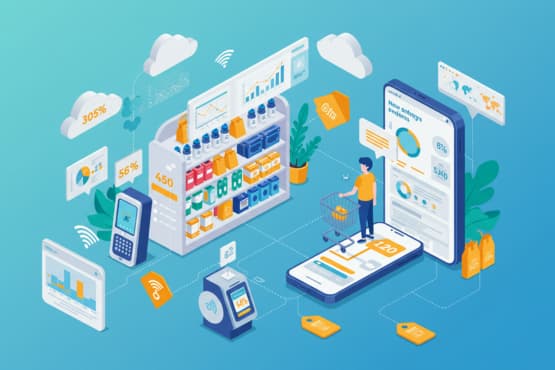
Customer Experience Enhancement
Modern customers expect seamless experiences across all channels, and IoT helps retailers deliver this omnichannel consistency. Mobile apps connected to in-store systems can guide customers to desired products, provide personalized recommendations, and enable contactless checkout options.
Hyper-personalization becomes possible when IoT data is combined with customer profiles and purchase history. A returning customer might receive personalized welcome messages, custom promotions based on past purchases, or suggestions for complementary products based on what they’re currently browsing.
Starbucks has created one of retail’s most successful omnichannel experiences by connecting its mobile app with in-store systems.
Customers can order ahead, earn personalized rewards, and enjoy seamless payment, all supported by an IoT infrastructure that connects digital and physical touchpoints.
Trade Marketing ROI & Data-Driven Decisions
Perhaps the most transformative benefit of IoT in retail is the shift from intuition-based decisions to data-driven strategies. By collecting comprehensive data about store operations, customer behavior, and promotional effectiveness, retailers can measure the actual impact of their marketing investments.
Campaign effectiveness measurement becomes more precise when retailers can track not just final sales but the entire customer journey.
For example, a promotional display might attract significant attention (measured by dwell time and product interaction) but generate few sales, indicating an issue with pricing or product messaging rather than the display itself.
B2B negotiations between retailers and suppliers benefit from enhanced data quality.
Rather than relying on basic sales figures, both parties can access detailed information about product performance, customer engagement, and promotional effectiveness, creating opportunities for more strategic partnerships.
Implementation Challenges
Infrastructure & Integration Barriers
Implementing IoT in retail environments presents several significant technical challenges. Network connectivity requirements can be substantial, with hundreds or thousands of connected devices requiring reliable, secure communications.
Many retailers operate with legacy systems that weren’t designed for IoT integration. Point-of-sale systems, inventory management software, and customer databases may require significant modifications or replacements to work effectively with IoT devices and data.
Walmart faced these challenges during its RFID implementation, requiring substantial investments in network infrastructure and system integration. The company’s phased approach, starting with distribution centers before expanding to stores, allowed for learning and adjustment throughout the process.
Data Privacy & Security Concerns
As retailers collect more detailed customer data, privacy and security concerns become increasingly important.
Regulatory compliance with frameworks like GDPR and CCPA requires careful data management practices, including clear consent mechanisms and data protection measures.
Customers are increasingly concerned about how their data is collected and used, making transparent privacy policies essential for building trust. Retailers must clearly communicate what data they collect, how it’s used, and what protections are in place.
Ethical data use extends beyond legal compliance to considerations of customer comfort and trust.
Even when data collection is legally permissible, retailers must consider whether their practices meet customer expectations and maintain positive brand perception.
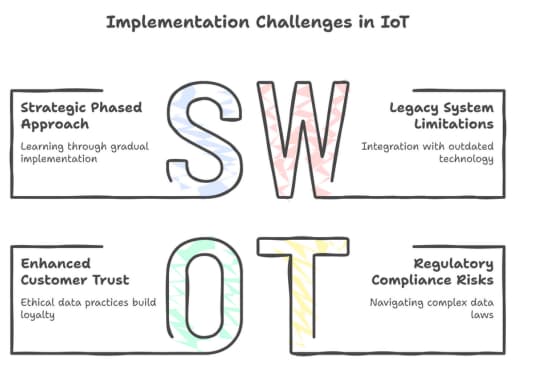
Cost vs ROI Analysis
The significant investment required for IoT implementation necessitates careful ROI analysis. Hardware acquisition costs include sensors, network equipment, and infrastructure upgrades, while software costs cover analytics platforms, integration services, and ongoing licenses.
Maintenance and updates represent ongoing expenses that must be factored into the total cost of ownership. As technology evolves, retailers must plan for regular upgrades and replacements to maintain system effectiveness.
Staff training and change management present additional challenges and costs. Employees must learn to use new systems effectively, and organizational processes must adapt to leverage the data and capabilities provided by IoT technology.
Target approached these challenges by focusing initial IoT investments on high-value applications with clear ROI potential. By demonstrating success in areas like inventory management and personalized marketing, the company built internal support for broader implementation.
Real-World Case Studies
Walmart’s RFID Implementation
Walmart has been a pioneer in large-scale RFID deployment, using the technology to transform its supply chain and in-store operations. The company’s approach demonstrates how IoT can address fundamental retail challenges like inventory accuracy and product availability.
The implementation began in Walmart’s distribution centers, where RFID tags on pallets and cases enabled automated tracking of goods through the supply chain. This foundation was later extended to individual items in select categories, creating end-to-end visibility from manufacturer to sale.
Results have been impressive, with Walmart reporting a 30% reduction in stockouts, improved inventory accuracy, and significant efficiency gains in receiving and shipping operations. These improvements have directly impacted sales through better product availability while reducing labor costs associated with manual inventory processes.
Amazon Go’s Cashierless Stores
Amazon Go stores represent perhaps the most advanced implementation of IoT in retail today. These cashierless convenience stores use a combination of computer vision, sensor fusion, and deep learning to create a “just walk out” shopping experience.
The technology works by tracking customers and products throughout the store. When customers take products from shelves, the items are automatically added to their virtual cart. When they leave the store, their Amazon account is charged for the items they’ve taken, eliminating the need for traditional checkout.
This system requires an incredibly sophisticated IoT infrastructure, with hundreds of cameras and sensors working together to track multiple customers and products simultaneously.
The result is a shopping experience that feels magical to customers while generating valuable data for Amazon about shopping patterns and product performance.
Starbucks’ IoT-Driven Supply Chain
Starbucks has integrated IoT throughout its operations, from coffee bean sourcing to final beverage delivery. The company’s Digital Flywheel program connects supply chain data with customer preferences to create a more responsive and efficient operation.
At the store level, Starbucks uses connected equipment to monitor coffee machine performance, predict maintenance needs, and ensure consistent product quality.
Temperature sensors ensure that products are stored at optimal conditions, while inventory systems track ingredients and automatically trigger reordering.
The company’s mobile app ties this IoT infrastructure directly to the customer experience, allowing for order-ahead functionality, personalized recommendations, and seamless payment.
This integration has helped Starbucks achieve a 15% revenue increase through better location selection and a more efficient, personalized customer experience.
Frequently Asked Questions
How does IoT store and process retail data?
Retail IoT systems collect data from various sensors and devices throughout the store environment and supply chain. This data is typically processed through a combination of edge computing (local processing near the data source) and cloud-based analytics platforms.
Edge computing handles immediate analysis needs, such as detecting when a customer picks up a product or identifying a potential stockout situation. This approach reduces latency for time-sensitive applications and minimizes bandwidth requirements by sending only relevant data to central systems.
Cloud platforms handle more complex analytics, historical data storage, and integration with other business systems. These platforms use advanced analytics tools and machine learning algorithms to identify patterns, predict trends, and generate actionable insights from the collected data.
What are the main benefits of IoT analytics in trade marketing?
IoT analytics transforms trade marketing—the collaborative strategies between manufacturers and retailers—by providing detailed data about product performance, customer behavior, and promotional effectiveness.
For retailers, these insights enable more strategic negotiations with suppliers, better allocation of promotional resources, and more effective merchandising strategies. Rather than making decisions based on limited sales data, retailers can understand the complete customer journey and optimize each touchpoint.
For manufacturers and brands, IoT data provides unprecedented visibility into how their products perform in the retail environment. This includes not just sales figures but details about product interaction, display effectiveness, and competitive positioning, allowing for more targeted marketing investments.
How does IoT help optimize trade promotions?
Traditional trade promotions suffer from limited visibility into actual performance. Sales figures show the end result but provide little insight into why a promotion succeeded or failed. IoT analytics creates a more complete picture of promotional effectiveness.
Sensor data can track how many customers noticed a display (through traffic analysis), how many engaged with it (through product interaction tracking), and how many ultimately purchased the promoted product. This granular view helps identify whether issues occur with awareness, interest, or conversion.
Real-time monitoring allows for mid-promotion adjustments based on performance data. If a display is attracting attention but not driving sales, retailers and brands can modify pricing, messaging, or placement without waiting for the promotion to end, maximizing ROI on marketing investments.
Conclusion
IoT in retail analytics has evolved from experimental technology to essential strategy for forward-thinking retailers. By connecting physical spaces with digital systems, retailers gain clear visibility into operations, customer behavior, and product performance.
The technology creates genuine competitive advantages: faster market responses, personalized experiences, and smarter decision-making. As AI, edge computing, and 5G mature, retailers who invest now in IoT infrastructure will maintain their edge.
Success requires defined business goals, careful technology selection, and a phased approach with measurable returns at each step.
Beyond technology, IoT in retail analytics creates more efficient, profitable stores that better serve customers—potentially the most valuable competitive advantage in challenging retail landscape.

